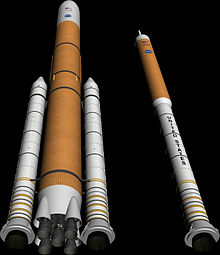NASA plans for future moon missions
Appearance
Monday, September 19, 2005
NASA has announced plans for sending humans back to the Moon, as a first step to Mars.

A 2018 lunar mission is proposed, where a crew of four would remain on the Moon for as long as a week. A minimum of two lunar missions a year is planned, with astronauts remaining as long as six months.
Some of the technology had previously been proposed for replacement of the Space Shuttle.
- Astronauts will be launched in a capsule, similar in concept to that used for the Project Apollo but three times larger. The top part of an Exploration Transportation System (ETS), the Crew Exploration Vehicle (CEV) will be a capsule attached to a service module which contains supplies, power, and propulsion units. The CEV is designed for use in Earth orbit.
- On lunar missions, crew or cargo versions of a Lunar Surface Access Module (LSAM) would be used with a CEV. The LSAM will have design concepts related to the Apollo Lunar Module, with a four-legged landing unit carrying an ascent stage.
- An Earth Departure Stage (EDS), a powerful propulsion unit, will be used to move CEV and LSAM units out of Earth orbit, such as on lunar missions.
- Heavy Launcher unmanned cargo rockets will be used for heavy loads of equipment.
- The launch rockets, Shuttle Derived Launch Vehicles, will use engines developed for the Shuttle program.
- CEV will be launched atop a Crew Launch Vehicle (CLV), a single solid fuel booster with a second stage using a shuttle main engine. The CLV can carry a payload of 25 metric tons into low Earth orbit.
- The heavy-lift system uses a pair of longer solid rocket boosters and five shuttle main engines to put up to 125 metric tons in orbit -- about one and a half times the weight of a shuttle orbiter.
- The use of a Launch Escape System (LES) will improve safety. A LES is a top-mounted rocket that can quickly remove the crew capsule away from an exploding or otherwise dangerous rocket.
For a lunar mission, the LSAM and EDS would be placed in orbit by a cargo launcher, then a CEV would dock with the assembly before leaving Earth orbit.

The goal is to begin production of the new spacecraft by 2011.
- Robotic missions will be sent, probably the first one in 2008.
- Past experience with lunar dust is being used in designing equipment and spacesuits which may encounter it.
- Surface mobility with open and pressurized rovers for use in such missions is also being developed.
- The CEV can be reused up to ten times.
- Crew capsule, upon return to Earth, will set down on dry land. It can also land on water.
- The CEV and lunar lander ascent stage use methane as fuel, as methane may be available on Mars.
- Eventually the designs could be expanded to support six astronauts for a trip to Mars.

The plans are a means to implement President Bush's "Vision for Space Exploration" program. Goals include:
- Implement a sustained and affordable human and robotic program to explore the solar system and beyond;
- Extend human presence across the solar system, starting with a human return to the Moon by the year 2020, in preparation for human exploration of Mars and other destinations;
- Develop the innovative technologies, knowledge, and infrastructures both to explore and to support decisions about the destinations for human exploration; and
- Promote international and commercial participation in exploration to further U.S. scientific, security, and economic interests.
Sources
- Traci Watson. "NASA to detail plans for trip to moon" — USA Today, September 18, 2005
- "A Renewed Spirit of Discovery" — White House, January 14, 2004
- "How We'll Get Back to the Moon" — NASA, September 19, 2005
- "Frequently Asked Questions" — NASA, September 19, 2005
|
| The text of this article has been released into the public domain. In the event that this is not legally possible, this article may be used for any purpose, without any condition, unless such conditions are required by law. This applies worldwide. Copyright terms on images, however, may vary, so please check individual image pages prior to duplication. Please note that this only applies to Wikinews content created prior to September 25, 2005. All content created after that date is released under a Creative Commons license which is mentioned at the bottom of each article. This is currently the Creative Commons Attribution 2.5 License. |

